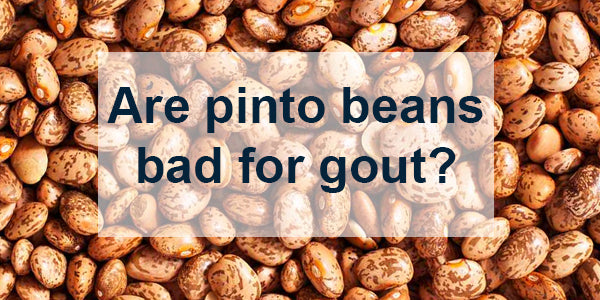Whether you are a long-time sufferer of gout or have just experienced your first flare-up, you’re likely looking for ways to reduce the impact of this painful condition. You may be aware that one of the most effective preventative measures you can take is to change your diet. But navigating a new diet can leave you with a lot of questions: What kinds of foods are good or bad for gout? For example, are pinto beans bad for gout?
What characterises a “good-for-gout” food?
Gout is an inflammatory condition caused by high uric acid levels in the body. Over time, this excess uric acid begins to form sharp crystals (called urate crystals) in the joints, which can cause severe pain, inflammation and swelling and limit mobility. Gout most often affects joints in the feet and ankles - particularly the big toe; however, it can affect other joints, too - including the knees, elbows, and shoulders. So, where does your diet come into all this?
Purines - a common compound behind gout
Well, one of the leading causes behind excess uric acid in the body is purines. Purines are an extremely common, naturally occurring compound that is present in a huge number of plant and animal products.
Purines also occur naturally in the body and form uric acid when they are broken down. In normal functioning, uric acid is expelled from the body via the kidneys in your urine; however, in some cases, this is not achieved effectively. This may be due to problems with the kidneys, such as kidney disease.
Purine is one of the most common compounds on the planet! As such, it can be difficult to completely cut them out of our diet, but limiting our intake by avoiding purine-rich foods (such as red meats, some fish and shellfish, and some leafy vegetables) can help maintain stable uric acid levels. But what about gout and pinto beans?
Are beans high in purines?
Beans and other legumes are often considered to be high-purine foods - a food product defined as containing more than 150 mg of purines per 100g. But the fact is, different legumes can contain extremely different amounts of purines. Take the list below (listed per 100g dried weight), for example:
- Black-eyed peas - 230 mg
- Lentils - 222 mg
- Small white beans - 202 mg
- Soybeans - 198 mg
- Pinto beans - 171 mg
- Red beans (including kidney beans) - 162 mg
You might think that all of the beans and legumes listed above - including Pinto beans - should therefore be classed as high-purine foods, but things aren’t quite as straightforward as they appear.
Are Pinto Beans bad for gout?
While it’s true that the beans and legumes listed above contain more than 150 mg of purine per 100 grams (approximately half a cup) of dried weight; however, when cooked, the yield comes in closer to a cup and a half, or around 150 grams - which would make up around three servings. Therefore, using a half-cup serving size, the actual purine content in Pinto beans would come in at around 57 mg - much lower than the 150 mg limit!
So, with all this in mind, it turns out that Pinto Beans may not be so bad for your gout, after all! In fact, as such as great source of plant-based protein (around 21g per 100g), Pinto beans may actually be a good addition to your new low-purine diet.
What else can I do to ease gout symptoms?
As we mentioned above, avoiding certain high-purine foods, as well as limiting your alcohol intake, can be extremely effective at preventing gout flare-ups. Other tactics that might help include taking regular supplements that help to reduce the levels of uric acid in your body. Staying hydrated is also recommended as one of the best things you can do to manage gout in the long term.
Conclusions
If you're considering adopting a low-purine diet, you might assume that you will have to stop eating some of your favourite foods. While it's true that many of the most popular food products, including steaks and cheese, are high in purines, you may not be as limited as you think.
Consuming your favourite foods, from fish to beans, in moderation, is generally fine. So, are pinto beans bad for gout? No! Like all foods, when eaten as part of a healthy, balanced diet, pinto beans can be a great source of nutrients in a low-purine diet.






